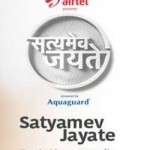 |
‘Gujarat Polls: Video Volunteers’ Community Correspondents report on elections issues from the grassoots |
 |
‘Untouchable’ No More:Activists are recording the stories of those deemed “untouchable” in the hopes of changing hearts and minds. Will the project work, or is caste no longer a problem? |
 |
India@65: Notes From the Margin: Technology has empowered large number of people to become filmmakers. In this episode we look at some of these unusual filmmakers – their stories as well as the stories they tell. |
 |
An Innovating Campaign to Fight Untouchability: Spreading its message all over India, is a campaign against untouchability run by Video Volunteers. |
 |
‘Untouchable’ Legacy Haunts India: Natalia Antelava finds that many low caste Dalit – formerly known as the “untouchables” – are still being discriminated against, six decades after the prejudice was officially outlawed. |
 |
Dignity4All: For a country which has been independent for 65 years, it is a matter of shame that we have not yet shaken off the tyranny of caste-based discrimination. Countless people have to live in degrading conditions, children are unable to go to school, employment avenues are closed, and even education does not open bigoted minds. Click here to watch. |
 |
Documenting Caste Discrimination in India:”Untouchability itself isn’t prosecuted, acts of violence are,” Mayberry said. “They need public awareness campaigns to end untouchability in same way that government campaigns have been successful at raising awareness about other things, like family planning and domestic violence.” |
 |
Video Volunteers: The Article 17 Campaign “The non-profit organization that aims to empower people in underdeveloped areas of India by teaching them video journalism skills and helping them create and broadcast media, Video Volunteers, is having a very busy week with their latest project, Article 17 Campaign, which addresses untouchability in India.” |
 |
Stalin K: On The Ground: Untouchability in India“Experiencing the immense power of moving images led me to question why only certain people were being allowed to tell stories… and defined what has become my life’s work with Video Volunteers in enabling marginalized communities to voice their grievances, fight for their rights, and create better lives for themselves.” |
 |
Under the Spotlight: Video Volunteers “Because voice is a human right; because there are masses of untapped creative potential in rural areas; and because we must bring the poor into the development discussions that have bearing on their lives, and from which they are now largely excluded. Community Video makes it possible for their voices to be included.” |
 |
India: Video Volunteers’ highlight fate of ‘untouchables’ “So far, Video Volunteers correspondents have produced 22 two- to three-minute spots documenting the continued practice of untouchability across India, adding to a library of more than 500 short films made by the outfit’s 100-odd full-time community producers.” |
 |
India’s Poorest Become Video Journalists “Mainstream media just report on the superficial events but they don’t have depth,” said Amol Lalzare, a Dalit and one of the “community correspondents” working for Video Volunteers, a media and human rights group. |
 |
Journalism From Below: Unheard Voices in IndiaDotare, entro cinque anni, ciascuno degli oltre seicento distretti dell’India di un reporter di comunità, in grado di portare allo scoperto le questioni reputate più importanti dalla gente del posto e facilitare in questo modo un processo capillare di cambiamento dal basso. E’ l’ambizioso obiettivo dell’iniziativa di giornalismo partecipativo IndiaUnheard (IU), che oggi, dopo due anni di rodaggio, conta su quarantotto corrispondenti dislocati in ventiquattro Stati. |
 |
Video Volunteers: India’s Newest Journalists shed light on HungerFor one, community people have access that outside professionals don’t. Even the best documentary filmmakers can often only spend a short period of time in a community. By contrast, a community member lives there all the time and has incredible knowledge and access that an outsider doesn’t, no matter how sensitive that outsider is. |
 |
Shaping in Action: Jessica Mayberry, Video StarShe spent nine months training rural women in the art of film-making. “I remember writing in my journal,” What if this is the beginning of a new direction in my life?,” recalls the 33 year old Native New Yorker,” What if I fall in love with India and stay forever?”
|
| |
|
 |
4 Insights and 4 Lessons:Knight News Challenge“For projects that rely on user-generated content, training can be a powerful tool for getting more people involved. The trainees enjoy the skill development, and it often inspires them to stick with the project. For example, Media Mobilizing Project and Video Volunteers, two citizen media efforts, effectively used training in Philadelphia and India to build relationships with the community and ensure people had the skills to produce content.” |
| |
|
 |
India Unheard team gathers in Goa for training programme; more reporters to join“Community correspondents of India’s first community based news service, India Unheard, run by the NGO Video Volunteers have landed in Goa for a ten-day training programme at their headquarters” |
 |
“simplwrds” blog by Media Researcher Dinesh Kumar, January 2011: What if the poorest half a billion people of India has their voice – it’s possible by innovative journalism“IndiaUnheard is the first ever community news service launched by VV. In this initiative, VV trains some volunteers from poor communities in India as community reporters. These reporters are trained with basic journalistic skills, and media training including the video training.” |
 |
Samhita.org, September 2010 – Video Volunteers: Telling the Untold “The mission of VV is to empower the world’s poorest citizens to participate in the community media movement so they can right the wrongs they witness and become players in the global media revolution.” |
 |
The Hoot, June 2010: Community Media – Varsha breaks the silence “Hi, I am Varsha. Three days after I was married, my husband beat me unconscious.” Not a conventional opening line — but then, Varsha is not a conventional reporter.” |
 |
Stanford University, May 2010: India Unheard: Video Journalism for Marginalized“Video Volunteers has launched a network of community journalists in India, each trained to tell their own stories in the form of video journalism. IndiaUnheard is the first-ever nationwide community video news service of its kind.” |
 |
Global Voices, May 2010: India: Video Giving A Voice To Marginalised Communities“Video Volunteers aims to empower the world’s poorest citizens to participate in the community media movement and make their voices heard.” |
 |
One World South Asia, May 2010: India launches ‘Unheard project’ on Press Freedom Day“A path-breaking project led by Video Volunteers will enable India’s poorest to speak about their problems rather than be spoken for. The country is launching the first community news service that will empower locals, as well as bridge the gap between production and distribution.” |
 |
MizoramExpress.com, May 2010: Christy Raj: Meet India’s first trans-gender journalist“I never got to vote. I have no ration card and no photo identity. Because I am neither male nor female. Official forms here do not have a clause for ‘other’ gender. I don’t get to apply for anything. And so, I don’t get anything, says Christy. |
 |
MOB Magazine, May 2010: India’s First Community News Network“By feeding community-produced content to national and international outlets, such as mainstream television channels and social networking platforms, IndiaUnheard will link rural communities with a truly global audience.” |
 |
The Hoot, May 2010: Community Media – Making learning easy through media“Under the Videoshala project, local youths are trained in video production, pedagogy and children’s unique learning needs so that they can produce films relating to the curriculum in a way that children find easy to understand.” |
 |
Syndication, March 2010: I’m here fishing for a good story – Actor Abhay Deol scouts for hidden talent among activists from rural India – in his words, the real India“…a community news service having a network of 31 social activists-turned-journalists representing marginal sections of the society including Dalits, Adivasis, trans-sexual and other minorities. …” |
 |
IndiaInfo.com, February 2010: Abhay Deol Roots for a camera-friendly cause“Abhay says, “This group teaches underprivileged people to bring out issues using the audio/visual medium…” |
 |
Yahoo! Movies, February 2010: Abhay Deol teaches journalism“Abhay Deol – the thinker’s actor has hopeful dreams for the nation and he plans to fulfill these dreams with a social organization called the Video Volunteers …” |
 |
 MSN Video, February, 2010: Abhay Deol for ‘Video Volunteers’ MSN Video, February, 2010: Abhay Deol for ‘Video Volunteers’ |
 |
Enterprising India, January 2010: Jessica Mayberry, Video Volunteers: How I Became a Social Entrepreneur“Seeing older, Indian women hiking up their saris and trudging through the mud with expensive, clunky, old-fashioned cameras challenged my preconceived ideas about who could and should make media.” |
 |
indiaglitz, January 2010: Abhay, Imtiaz Promote Video Volunteers“The actor along with filmmaker Imtiaz Ali had visited the event organised by VV and the NGO Akshara in Chembur. It had screened the videos made by slum dwellers…” |
 |
 YouTube, January 2010: Abhay Deol encourages slum kids to make films“The films screened here were made by the slum children and were meant to raise awareness for social issues like sexual harassment and poverty…” YouTube, January 2010: Abhay Deol encourages slum kids to make films“The films screened here were made by the slum children and were meant to raise awareness for social issues like sexual harassment and poverty…” |
 |
newKerala.com, January 2010: Abhay Deol signed on as the Brand Ambassador of Video Volunteers“Abhay Deol says, “‘Video Volunteers’ has created a movement based on the idea that the poor in India have a right to voice and to express themselves creatively…” |
 |
Indyarocks, January 2010: Abhay Deol to endorse Video Volunteer – a community service projectPhotos of Stalin K, Video Volunteers Founding Director, India, with Abhay Deol at a Community Film Screening |
 |
One World South Asia, April 2008: Community video empowers rural India“Video Volunteers and local NGOs are helping rural communities in India voice their issues to a global audience. Locally relevant video produced by community video units, are empowering people to lead, change and take action.” |


































